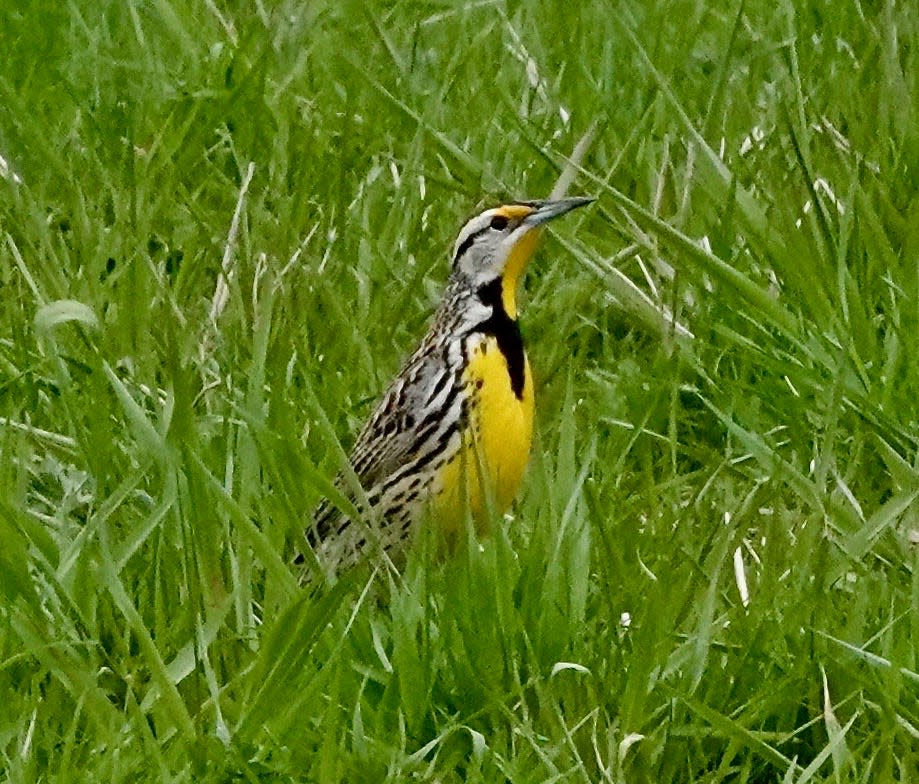Meadowlarks are tricky to spot. Here are some tips
If I ask, “Are meadowlarks beautiful?” you may not know.
One reason is these birds don’t show off. Except for the occasional nuptial flight, this blackbird-related beauty prefers blending in to standing out.
As a consequence, getting good looks comes with difficulty. Perhaps I can help. I don’t get many good looks, either, but I’ve been chasing meadowlarks so long that a few viewing opportunities have come my way.

Here are some tips, then, on finding meadowlarks and viewing them.
To locate a meadowlark, you must first find a meadow. That might seem easy, but no.
Grassland habitat has disappeared at an alarming rate in recent decades, due to hay fields and pastureland being abandoned or developed.
Once you find a meadow, make sure it does not have shrubs growing in it. Meadowlarks like open grassy places.
Having located such a place, your next challenge will be slowing yourself down. Patience is vital. Meadowlark watching is the birding world’s equivalent of a stakeout.
Park near a fencepost bordering your chosen meadow. Relax. Let your quarry come to you. The best time to undertake this is now, while meadow grass is short.
More: Spring has sprung in the Southern Tier. Enjoy it while it lasts
The taller the grass, the easier it is for meadowlarks to disappear in the tufts it creates. These birds walk a great deal, obscured by grassy tangles. They build their nests in such tangles. They feed in these tangles, snapping up grasshoppers, crickets and weed seeds.
You can observe meadowlarks in the air, however. To watch one in flight is to see something ordinary happening.
They perform neither death-defying dives nor endless majestic glides. Long of bill but rather short of wing, meadowlarks progress through the air. That’s about all you can say. They rise off the ground, then flap a bit with stiff wingbeats, then glide a short distance, then repeat.
As your meadowlark flies away, you will note little color save for white outer tail feathers. The rest of your view – the bird’s back, wings and head – comprise a camouflaged blend of beige and gray streaks.
A meadowlark beautiful? You’ll think me crazy after watching one’s backside disappear over a distant hedgerow. I’m not, though. You must give the stakeout more time.
Your turning point moment might arrive around dusk on a warm evening in early May. Meadow grass will be growing by then, a lush replacement for drab winter browns. A domelike nest may well be in progress, artfully concealed beneath a meadow tussock. There might even be youngsters in the nest. This will be a busy time for meadowlark parents, but eventually one bird will land on a fence post to rest.
Your patience will now be rewarded. You can raise your binoculars and stare at the bird’s exposed front. Astonishing.
Your drab, chunky, stiff-tailed meadowlark, be it male or female, will show off brilliant lemon yellow from throat to abdomen.
Emblazoned across its breast will be a glossy black “V” – a big, splashy one you can’t miss.
Superman, your “S” ranks second best. Zorro, your “Z” hints at excitement but falls short.
Meadowlark, you are beautiful, brighter than spring.
E-mail Rick at rmarsi@stny.rr.com
This article originally appeared on Binghamton Press & Sun-Bulletin: Meadowlarks are tricky to spot. Here are some tips
